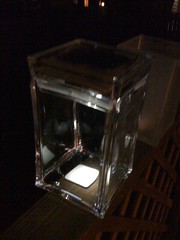Sunday, December 6, 2009
Cycling Xtranormal Videos
Collection of Xtranormal Cycling related videos:
Made with tools from "Xtranormal":
Hipsters discussing Cyclocross
Zone 2 (stupid crap cyclists say)
PDX Chat before CX Natz
Wheel Change
Colorado State Cyclo Cross Championships Discussion
Post Colorado State Cyclo Cross Championships Discussion
Typical pre-ride conversation
Typical post-ride conversation
Tuesday, October 13, 2009
TED5000 support with Google PowerMeter

I was pretty excited last week to see that Google announced support for TED5000 in their newish PowerMeter application (announcement). I scrambled to get the new firmware installed and talking to the big Google in the sky as soon as I could. First impression is I'm a little disappointed in the lack of bells and whistles, but hey it's better than my hacked together RRD graphs! I read here or there that they are suppose to be adding more advanced features to come as it catches on. We'll see....
Essentially, the new firmware just gives you a section in the settings to hook up with your iGoogle account. When you get it rolling, it will add a new widget or whatever Google calls them (first time using iGoogle). I can't wait to see ways of comparing your usage to other users, or common trends in your area, or even +/- than in the past would be great too.
Makes me really wish I had a electric water and house heater as the temperature continues to drop in Colorado lately.
Monday, August 31, 2009
Project Updates, 8/31/2009
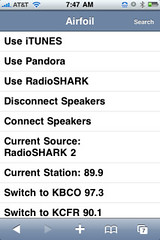
I've been entirely focused on wiring the house for ethernet so I have not gotten to much else lately. Here's where everything is at:
Whole House Audio
I have not been wanting to invest any more money in this project until I made some progress on others so it's pretty stalled from a growth standpoint. I did work on the iphone interface a little bit but it still needs to be updated with other features I've thought of. As it stands right now I have the Mac Mini brains of the operation upstairs in a den with speakers, airport express in our bedroom with speakers, HTPC
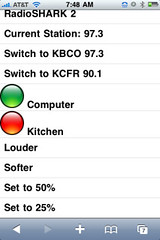 using the Speakers application in the living room. Right now I can play to three different rooms. Mostly I only play a local radio station KBCO or iTunes right now. I control it all from my iPhone (or IE on a desktop, firefox doesn't work for some reason).
using the Speakers application in the living room. Right now I can play to three different rooms. Mostly I only play a local radio station KBCO or iTunes right now. I control it all from my iPhone (or IE on a desktop, firefox doesn't work for some reason).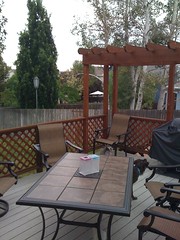 Solar Sun Jars
Solar Sun JarsI used hot glue to hold everything in place the last time around inside the lid. I didn't consider the how hot the sun could heat these up in the middle of the day. Yeah... that's not lasting.. I need to replace it with some sort of super epoxy. They are good looking at least with the colored gels in the lids sitting out on our new patio furniture!
Energy Monitoring (TED5000):
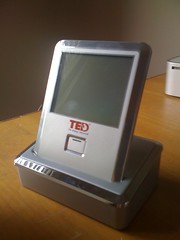
I received the display the same day all my networking tools and equipment came so I didn't really touch it for a few days. First impression is it's a bit cheaply made for what it is and costs. Just feels like one of those cheap plastic doodads you get at Bed Bath and Beyond BUT I will say it's a pretty sweet little device. If I didn't have the web interface on my phone or my own graphs going - this would be pretty useful for the majority of users! Also, I have hijacked some old scripts I had laying around for temperature monitoring and used them to pull data from the TED api and stick into some RRD's and export some graphs like this below. Quick and dirty but a little more useful for me if I start to have bad readings again.

Networking, Structured Wiring:
Short of it is I wired up ethernet in two rooms going to the basement where I have a patch panel and a new switch. Detailed post on it coming up.
Tuesday, August 25, 2009
TED problems and fixes
1) I had been getting weird readings like HUGE numbers and negatives all of a sudden even after updating to the newest firmwares. Support sent me a beta update that took care of it right away and actually seems to make it work a lot smoother. One of the updates was for the gateway but the other was actually for the box that connects to the breakers. It must send the data over the power lines since it took about an hour for it to complete. Slick...
2) All of a sudden the other day readings were at zero. I didn't notice it but support pointed out that if I wasn't getting green lights, the gateway wasn't getting word back from the mtu. Long story short - through quite a bit of trial and error I figured out the outlet I was using in the basement for Datacenter 1.0 was the same circuit as an outlet in the garage which I had plugged an Airport Express and Bose speakers into. The Bose powered speakers must be putting some noise on the power line to interrupt communication.
It looks like I averaged about 30 kWh's a day over the weekend when it got to the 90's and the swamp cooler was on quite a bit while we were home. We'll see how that evens out over this week. Very interesting.... I am just itching now to figure out a way to track water and gas usage...
sure missed THAT at the inspection
 I do remember the inspector taking a second look at part of the insulation but he wasn't too concerned about it if I remember right. crap. From the first few days in the house I thought part of the insulation in the basement looked funny. As I have been rooting around back there trying to figure out the best way to lay out some network cable for my newest project (post on that coming!) I realized what was going on.
I do remember the inspector taking a second look at part of the insulation but he wasn't too concerned about it if I remember right. crap. From the first few days in the house I thought part of the insulation in the basement looked funny. As I have been rooting around back there trying to figure out the best way to lay out some network cable for my newest project (post on that coming!) I realized what was going on. At some point in the past a mouse has moved in and ain't paying rent! I first noticed a few droppings, then realized some ripped up insulation went deeper than i thought and it actually turned out to be quite a nice little mouse apartment. a little digging and....ACK! A little mouse skeleton picked clean. What the.... Ok so I know now a) why the insulation on part of this wall looks jacked up, and b) why nobody fed on my mouse traps, but that brings to question 1) what the crap picked the bones clean and 2) It's not that large of a spot of insulation that needs replacing, but is that something I really want to do myself?
Sigh....home0wning.....
Thursday, August 20, 2009
TED Introduction and Installation
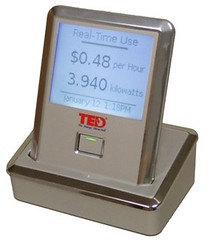 I've always been curious about the Kill-a-Watt device works but never could rationalize getting one since it's so limited. In a nutshell, it is a device (or powerstrip) you plug into the power outlet then plug in one or more electronics to it and it will read out your power usage. I read some models will calculate your cost of the power as well. Looking into gadgets for the new home I came across what I call a “whole house Kill-a-Watt” - The Energy Detective (or TED).
I've always been curious about the Kill-a-Watt device works but never could rationalize getting one since it's so limited. In a nutshell, it is a device (or powerstrip) you plug into the power outlet then plug in one or more electronics to it and it will read out your power usage. I read some models will calculate your cost of the power as well. Looking into gadgets for the new home I came across what I call a “whole house Kill-a-Watt” - The Energy Detective (or TED).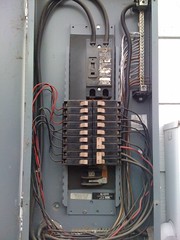 TED, made by Energy Inc, http://www.theenergydetective.com/index.html has had their first generation product out for a while it looks like. I read that the next generation – the 5000 series – just came out this summer in 2009. I figured this was a perfect opportunity to get in on it as well as starting to monitor our power usage from almost day 1 in the house. I found they did not have the 5000 series listed for sale online but according to a few blogs you could call them up and make an order. I sent an email to find out more and their very helpful support let me know the main reason for not being for sale online was they only have a few still in stock and are totally out of the remote display device. I went ahead and made an order for the TED 5000-C which included everything I need for one electrical panel, the webserver that they call their gateway and a display that they will ship later. $256 shipped
TED, made by Energy Inc, http://www.theenergydetective.com/index.html has had their first generation product out for a while it looks like. I read that the next generation – the 5000 series – just came out this summer in 2009. I figured this was a perfect opportunity to get in on it as well as starting to monitor our power usage from almost day 1 in the house. I found they did not have the 5000 series listed for sale online but according to a few blogs you could call them up and make an order. I sent an email to find out more and their very helpful support let me know the main reason for not being for sale online was they only have a few still in stock and are totally out of the remote display device. I went ahead and made an order for the TED 5000-C which included everything I need for one electrical panel, the webserver that they call their gateway and a display that they will ship later. $256 shipped
The box showed up pretty quick and I was excited to get it installed that night. Everything looked to be included with nothing missing, great experience so far. I was pretty familiar with the electrical system of the house since the inspector I hired took the time to explain every bit of the house to me in detail. I knew all the breakers were being used but there was room for more. A quick jaunt to the hardware store (literally a minute from the house) to pick up a breaker and I was in business.
The MTU consists of two clamps that attach to the incoming power feed, that connects to a small box placed inside the box. Three wires come out of the box, 1 for the A phase, 1 for the B phase and another to attach to the ground bar. The only trouble I had installing was a slight fear of killing myself in one of the very first projects of the house, and that I ran out of sunlight. The wife and dogs weren't too happy about having the power shutoff while I got it installed. All said and done no death and still married! I do still need to clean up the box by attaching the MTU with doublesided tape to the side, right now it's just sitting on the bottom. Thanks to the wonders of battery backup, I noticed my computers and internet connection stayed up. Microwave clock flashing 12:00 was not as lucky.
“Well that was easy” I thought, “I'll surely have issues installing the gateway, I mean a company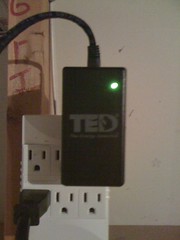 focused on a utility can't have that much experience with a computer device.” I went ahead and plugged in the gateway which consists of a wall wort sort of box, and an RJ45 port for a network cable. LED's started flashing as I read it should, excellent. I got onto a web brower and tried to hit up the web interface on the URL provided in the documentation, but all my systems are configured for my own search domain. This meaning it would try to autocomplete http://TED5000/ to TED5000.mydomain.blah.com or just TED5000.com. I pulled up my routers web interface and was able to track down the IP that TED got from DHCP and was then able to pull up the webpage. Granted this was mostly an environmental issue in my own network, it would be nice if they had a default static address – it's a trade off either way I suppose. Doing it this way is probably easier for the majority of users.
focused on a utility can't have that much experience with a computer device.” I went ahead and plugged in the gateway which consists of a wall wort sort of box, and an RJ45 port for a network cable. LED's started flashing as I read it should, excellent. I got onto a web brower and tried to hit up the web interface on the URL provided in the documentation, but all my systems are configured for my own search domain. This meaning it would try to autocomplete http://TED5000/ to TED5000.mydomain.blah.com or just TED5000.com. I pulled up my routers web interface and was able to track down the IP that TED got from DHCP and was then able to pull up the webpage. Granted this was mostly an environmental issue in my own network, it would be nice if they had a default static address – it's a trade off either way I suppose. Doing it this way is probably easier for the majority of users.
 My first experience in the web interface was simply – WOW, this is well done. After walking through some simple setup wizards the gateway was picking up the signal just perfectly from the electrical panel. “It just can't be this easy” I thought. A day or two later I finally did hit a stumbling block, I started getting bad readings in the history, both huge numbers and negative. Even updating the firmware from the newest on their website was not fixing it. An email to support produced a quick email from one of their engineers, and a beta firmware update for both the MTU and Gateway. Now that's what I call service from what surely is a small company and not a very expensive device! After running for 12 hours on the new firmware it looks great. I could be wrong, but the interface seems to work a lot better, snappier between pages and the data seems to be more consistent and accurate.
My first experience in the web interface was simply – WOW, this is well done. After walking through some simple setup wizards the gateway was picking up the signal just perfectly from the electrical panel. “It just can't be this easy” I thought. A day or two later I finally did hit a stumbling block, I started getting bad readings in the history, both huge numbers and negative. Even updating the firmware from the newest on their website was not fixing it. An email to support produced a quick email from one of their engineers, and a beta firmware update for both the MTU and Gateway. Now that's what I call service from what surely is a small company and not a very expensive device! After running for 12 hours on the new firmware it looks great. I could be wrong, but the interface seems to work a lot better, snappier between pages and the data seems to be more consistent and accurate.
I also came across an unofficial iPhone app that simply connects to the API of TED's gateway and shows all the current information. Not having the display yet, this is pretty handy to walk over to some lights, check the usage, turn them off and re-check. I am slightly disturbed that the 20 year old clothes washer that came with the house uses so much dang electricity! Newer ones have GOT to be more efficient.
In summary, it seems totally worth the cost as just being mindful of usage day to day, and parts of the day will go a long way to efficiently turning things off when not using or tracking down something I left on. Time will tell though, I'll be sure to track my progress here.
Tuesday, August 18, 2009
Sun Jar Project
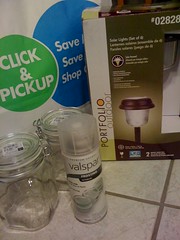
I built the first of many solar powered lights for the deck this past week. I wont dive into the details as I just followed plans from lifehacker and instructables. Here are some of the specifics and changes I made.
The first jars I tried came from The Container Store but the lids seemed entirely too small even with a heavily gutted light. It was the flip top mason jar looking ones but just couldn't get it to work. Next I tried a hard plastic (and watertight) square jar from Wal-Mart that worked perfect.
My parts:
6 pack of lights - Portfolio brand, from Lowe's $22
Jars $3/each from Container Store
Frosting $3 from Lowe's
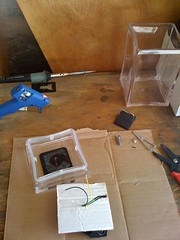
I pretty much dove into this without doing too much reading of other peoples advice. I'll probably go back and read through all the comments to find the best way to color the lights as the green soda bottle I tried seemed to filter too much light.
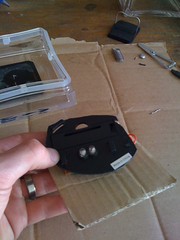 I ended up needing to solder the two wires for the solar panel because they kept getting disconnected when I took apart the lights. Basic soldering I am fine at but it's no where near pretty! I couldn't find much to use as a cover inside the top to hide the electronic bits, ended up using a cardboard square. I should find something metal and hopefully black to pretty it up.
I ended up needing to solder the two wires for the solar panel because they kept getting disconnected when I took apart the lights. Basic soldering I am fine at but it's no where near pretty! I couldn't find much to use as a cover inside the top to hide the electronic bits, ended up using a cardboard square. I should find something metal and hopefully black to pretty it up.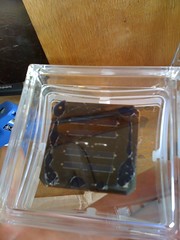
The frosting was much easier than expected, dead simple. I thought it was going to bunch up or streak or have SOME sort of problem on the plastic but it went on just fine.
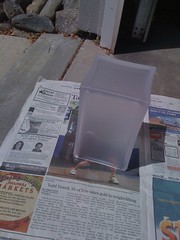 Everything worked fine after putting her together. Looks to be water tight and a few days later looks like it's charging as well.
Everything worked fine after putting her together. Looks to be water tight and a few days later looks like it's charging as well.Next:
- Frost the top to hide the bits
- Research where to get filters for color
- Build more!
I'll get some better pictures of them on the porch when I get more built up!
edit: yes i see the layout of the pictures is all jacked up. i need to figure out a better composer for this blog!
